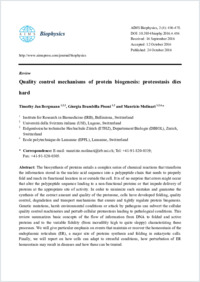Quality control mechanisms of protein biogenesis : proteostasis dies hard
- Bergmann, Timothy Jan Institute for Research in Biomedicine (IRB), Faculty of Biomedical Sciences, Università della Svizzera italiana, Switzerland - Eidgenössische technische Hochschule Zürich (ETHZ), Departement Biologie (DBIOL), Zurich, Switzerland
- Brambilla Pisoni, Giorgia Institute for Research in Biomedicine (IRB), Faculty of Biomedical Sciences, Università della Svizzera italiana, Switzerland
- Molinari, Maurizio Institute for Research in Biomedicine (IRB), Faculty of Biomedical Sciences, Università della Svizzera italiana, Switzerland - Ecole polytechnique de Lausanne (EPFL), Lausanne, Switzerland
-
24.10.2016
Published in:
- AIMS biophysics. - 2016, vol. 3, no. 4, p. 456-478
Protein synthesis
Translation
Folding
Quality control
ER-associated degradation (ERAD)
Autophagy
Unfolded protein response (UPR)
Central dogma
CAT-tails
Proteostasis
Conformational (protein misfolding) diseases
Chemical and pharmacological chaperones
English
The biosynthesis of proteins entails a complex series of chemical reactions that transform the information stored in the nucleic acid sequence into a polypeptide chain that needs to properly fold and reach its functional location in or outside the cell. It is of no surprise that errors might occur that alter the polypeptide sequence leading to a non-functional proteins or that impede delivery of proteins at the appropriate site of activity. In order to minimize such mistakes and guarantee the synthesis of the correct amount and quality of the proteome, cells have developed folding, quality control, degradation and transport mechanisms that ensure and tightly regulate protein biogenesis. Genetic mutations, harsh environmental conditions or attack by pathogens can subvert the cellular quality control machineries and perturb cellular proteostasis leading to pathological conditions. This review summarizes basic concepts of the flow of information from DNA to folded and active proteins and to the variable fidelity (from incredibly high to quite sloppy) characterizing these processes. We will give particular emphasis on events that maintain or recover the homeostasis of the endoplasmic reticulum (ER), a major site of proteins synthesis and folding in eukaryotic cells. Finally, we will report on how cells can adapt to stressful conditions, how perturbation of ER homeostasis may result in diseases and how these can be treated.
- Language
-
- English
- Classification
- Medicine
- License
- Open access status
- gold
- Identifiers
-
- RERO DOC 326895
- DOI 10.3934/biophy.2016.4.456
- ARK ark:/12658/srd1318885
- Persistent URL
- https://n2t.net/ark:/12658/srd1318885
Statistics
Document views: 192
File downloads:
- Texte intégral: 159
